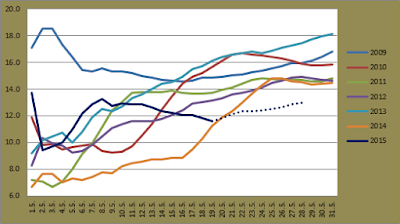April in 2015 was a month filled with exceptional weather observations in Sydney. Sydney Airport saw many extremes throughout, some of which were the highest and lowest respective figures for several years, but the key part of the month came on April 20, 21 and 22 when an extensive and damaging storm system struck the New South Wales coast. In the end, the average minimum held above the long term figure at the Airport, the average maximum was below, and the monthly rainfall total was three times the average and the highest for a month since May 2003.
The graph below shows the averages for April during the past seven years. The long term figure is also shown.
 |
| April averages at Sydney Airport for the period 2009-2015 plus the long term average |
The Bureau of Meteorology recorded slightly higher averages of 15.3C and 22.6C. The failure of the average maximum to exceed the long term figure is the first occurrence since August last year. It also became the 39th month since the start of 2000 to record a below average maximum. That means almost 80% of the months since 2000 have been above the long term figure.
While the average maximum recorded a below average figure, the average minimum was once again above the long term recording. Since the start of 2009, there have been only two months, May and December in 2011, which recorded a below average average minimum.
The hottest day of the month was April 16 when it reached 32.6C at the Airport. That figure was the highest April temperature since 2006. April 2's 31.0C was also higher than any other April figure since 2006. The lateness of the 32.6C recording on the 16th was unusual too. Only once before in Sydney Airport's 77 years of April recordings has a temperature exceeding 32.6C been recorded later, but before winter, than April 16. That occurred in 2005 when 33.9C was seen on April 18.
The warmest minimum for the month was 20.1C on April 18. This was the highest figure in the years since 2009. The Bureau's differing methodology for recording temperatures limits my search for this figure, but they recorded April's highest minimum at 20.2C for the 18th and, according to their records, it is the highest since a 20.3C recording in 2009.
The two coldest days were part of the April 20-22 storm. It topped 17.2C and 17.1C on the 20th and 21st. These were also the lowest since 2009. The overall lowest temperature came on April 28. It fell to 10.6C then. It was also 10.7C on the 29th. These are the lowest April temperatures since 2012. Only three daily minimums have been below 10C in Aprils since 2009.
The April 20-22 storm accounted not only for the coldest days of the month, but also the wettest and windiest. Rainfall would have been extraordinary for any month of the year in Sydney. A total of 338.4mm fell across the calendar month of April, while the Bureau's total of 349.0mm was more than triple the long term average of 109.3mm.
 |
| Daily minimums and maximums against rainfall at Sydney Airport for April 2015 |
April 2015 was the second wettest April at Sydney Airport in its 86 year history of rainfall recordings and the wettest month overall since May 2003. For the month of April, only 1988's remarkable 476.2mm is higher, while only six Aprils since 1930 have exceeded 300mm. At Observatory Hill the monthly total was 366.8mm, making it the seventh wettest April there since records began in 1859 and the wettest since 1989.
At the Airport there were 21 days of rain. The longest streak was eight, from April 16 to 23, while the longest dry streak was only four, from the 12th to 15th. The wettest day was April 22 when 111.2mm fell. April 20 and 21 saw 73.0mm and 63.6mm, bringing the three day total to 247.8mm. As mentioned in
a previous post, the Bureau's three day total of 241.8mm was the highest three day total in over 23 years.
Wind gusts were also quite remarkable. The maximum gusts from the storm didn't exceed those seen last October, which were over 100km/h, but April 20, 21 and 22 recorded maximum gusts of 96km/h, 91km/h and 89km/h. Direction of these gusts were south-southeasterly (96km/h) and the remaining two were southerlies. The average of maximum gusts for the month was much higher than the previous two Aprils. April 2015 saw an average of 51.9km/h, compared to 40.5km/h in 2013 and 43.3km/h in 2014.
At the other end of the spectrum, the calmest maximum gust was a case of the calm before the storm. The 26km/h east-northeasterly gust came on the 17th.











